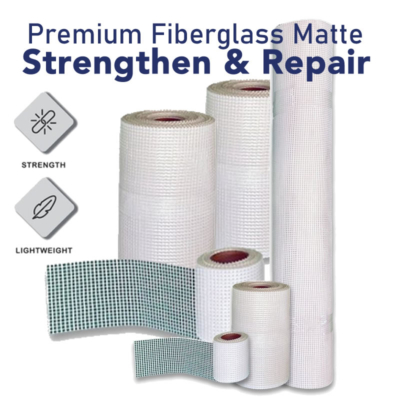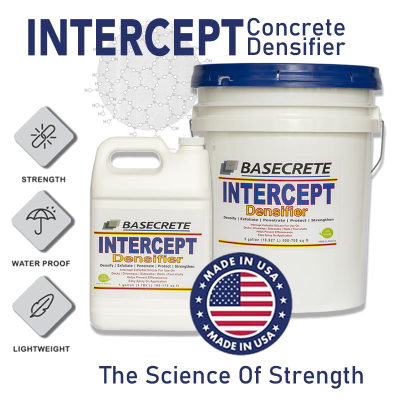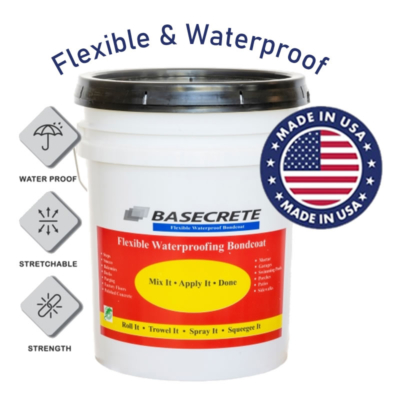Low VOC's Help Our Environment
With almost no volatile organic compounds, Basecrete is great for installers and end-users. No harmful off-gassing and fast cure times.
Drinking Water Safe
Basecrete is one of the world’s ONLY drinking water safe waterproofing compounds. So safe, even the MOTE aquarium uses our products.
Scientifically Formulated
Years of research and development have enabled Basecrete to achieve unrivaled results with almost NO environmental impact.
Common Basecrete FAQ's
Bascrete Packaging
Basecrete is sold in kits. One kit of Basecrete consists of;
- One 5 Gallon Pail of Basecrete liquid.
- Three 50lb bags of Basecrete compound.

Basecrete Compound is available in three standard colors;
- Black, Grey and White

Coverage per Kit;
- One kit will cover 450 – 500 square feet at 1/16th inch – enough for bonding applications.
- One kit will cover 225 – 250 Square feet at 1/8th inch thickness – required for waterproofing applications.
These are the most common application thicknesses when applying Basecrete as a coating. To calculate your material requirements you would divide area to be covered by…
- 225 @ 1 /8th inch application thickness
- 450 @ 1/16th inch application thickness.
Note: You should know your application thickness before purchasing material.
Example: 7500 square feet @ 1/8th inch would equal 7500 / 225 = 33.3 Kits round up to 34 kits
- Option to add extra kits in case of unexpected material use such as patching or crack repair.
Basecrete liquid can be stored for up to two years, even after opening container. Simply close up pail and store out of direct sunlight. Note: Basecrete liquid can NEVER be allowed to freeze or it will be destroyed.
Basecrete Compound contains cement and as such potency may be reduced after 12 months.
Installation Tools
Basecrete is amazingly easy to mix and only requires commonly used tools which are neither hard to come by nor expensive. These can all be purchased in your Home Depots’ Lowes, etc.
List of Tools:
- Paddle Mixer
- Min pails; one to mix in one for water
- Margin Trowel
- Masonry Trowels
- Paint Brushes: for detail work & hard to reach areas
- Water for tools and able to reach entire area to be coated.
- Protective coverings; tape, plastic, tarps, etc
- Gloves & PPE
- Basecrete Fibermesh: to reinforce areas of stress (cracks ), over 2 diff materials.
- Application tools
- Trowel
- Paint Roller; heavy nap ¾ inch – 1/4inch
- Squeegee
- Hopper Gun
Substrate Prep
A properly prepared substrate can mean the difference between a successful application and a failed one. Proper prep of the substrate ensures Basecrete will bond to the substrate as planned.
Concrete substrates should be clean and clear of dust & debris per ASTM standards.
Concrete substrate should be SSD – Saturated Surface Dry. This is an industry term that describes a concrete that is wet, but there is no standing water. This is what is required for a good Basecrete application.
There are two key reasons for this
- Bring thermal temperature of concrete down if it is baking from exposure to the sun. Applying Basecrete to burning hot substrate will cause the Basecrete to Flash dry before it has a chance to adhere to the substrate.
- Moisture inside the concrete will attract cement that is in the Basecrete compound drawing the Basecrete into the substrate for enhanced bonding.
NOTE: All porous substrates should be wet down per above immediately prior to the application of Basecrete. Examples include Plaster Finishes, Natural Stones, CMU block, Gunite and Shotcrete etc.
On Non-porous substrates care should be taken to endure there are no oils or other agents that might inhibit bonding. Stainless steel for example is often delivered with a sheen of oil which must be removed prior to applying Basecrete. Can simply be wiped off with a cloth.
At the end of that day it is plain common sense. We are looking for a substrate that is clean and free of debris with an ambient temp of no more than 80 degrees.
Basecrete Mixing Instructions
Basecrete is mixed on-site immediately prior to use. Before we get into the actual mixing there are a few concepts that are important to know about Basecrete.
- BC is a polymer modified cement mix and as such it sets up quickly.
- Heat accelerates the setting of BC
- Cold SLOWS the setting / curing of Basecrete.
The first rule of Mixing when it comes to mixing Basecrete is that we mix to a consistency, not a ratio. We mix Basecrete to a…
- Thicker than water but still liquid consistency
This is a particularly important concept to understand. For instance, an applicator in the Arizona Desert at 110 degrees ambient temperature will have a very different mixing ratio than an applicator working in Maine at 65 degrees ambient temperature. So, to get around this we came up with the idea of.
- Basecrete is mixed to a consistency and not a ratio
Having said this, we obviously need to start somewhere so here you go; the official mixing instructions for Basecrete Waterproofing.
- Add one measure of liquid to the mixing pail / bucket – always add liquid component first
- Add two measures of compound and mix thoroughly with your paddle mixer. Mix for 2 to 3 minutes until all lumps are gone and the mix is homogenous. At this point your mix should be a very liquid grey, basically like grey water.
- Keep adding compound until a thicker than water but still liquid consistency is achieved.
- Let false set for 3 to 4 minutes, remix thoroughly for an additional 45 seconds. Note: in hotter temperatures it may already be necessary to add a dash of liquid to the mix before re-mixing.
- Apply immediately.
So, to summarize, the two key points to take away from this section are
- Basecrete is mixed to a consistency (over a ratio)
- Let mix false set for 3 – 4 minutes.
I want to take a moment to explain the reason for the false set step. This is an important step in the application process that should not be overlooked. When the liquid and dry components of Basecrete are first mixed a chemical reaction begins to take place. You have molecules and atoms being drawn together and bonding and such. By breaking this chemical reaction, you force it to reset and when it does you will achieve a stronger end result than had you not broken the reaction. It is a similar concept to when you break a bone, where the bone knits itself together the bone becomes stronger. Likewise, by forcing the molecules and atoms to reset, you achieve a finished Basecrete that is 20% stronger than had you not.
Basecrete Dry Mixing Tips
In the previous section we talked about mixing Basecrete to a…
- Thicker than Water but still Liquid Consistency
This is also what we refer to as a” wet” mix. This is the most common way of preparing and using Basecrete. There is however one other way of preparing Basecrete for certain application that we refer to as “Dry Mix Prep.”
A dry mix is simply a wet mix that you have added more compound to creating a mortar like consistency ( instead of the liquid lie consistency ) There are two levels of dry mix and they are mainly used for applications that involve patching and concrete repair.
In creating your wet mix, you ended up with a ratio of about 2.5 to 3 parts compound to one part liquid. Here we are increasing that up to 4 to 1 ratio even 5 to 1 ratio in certain circumstances.
This is what we would refer to as a Mortar mix. You would use a mortar mix to repair profiles, repair cracks in concrete slabs, repair concrete spalling. These are generally applications where the application thickness of the BC is from 0.5 inches up to two inches.
Then there are applications that require even more material. Here we are talking about applications that require even higher volumes of material. Now we typically think of BC as a coating, used to cover and seal concrete structures, but in certain application we can use Basecrete as a concrete repair mortar. Here we are taking applications such as deep concrete Spalls and deep patch repairs.
Note in these applications where BC is being used to fill out voids or to raise levels one can think of adding a volume filler to the Basecrete mix such as pea gravel. You can up to a third volume of pea gravel.
Key Mixing Tips For Basecrete
The purpose of this section is to give applicators a couple of helpful hints and tricks that we have picked up over the years.
1. Extending Pot Life
- We mentioned earlier that Polymer modified cement sets up quickly. This is accelerated the hotter it gets.
- Agitate your mix during application: depending on your application method, if you are able to agitate your mix inside your bucket it will stay “loose” longer. For instance if every time you dip your paint roller into the bucket you plunge it to the bottom one or two times each time you return for material you will notice an improvement in pot life.
- Re-mix a “ stiffened batch”
Maybe you had to take a call and your mix has stiffened up on you while your attention was diverted. Simply re-mix the entire batch with the paddle mixer and it will return to a liquid state. You may need to add a splash of the liquid as well. - Use BC to adjust slump of Basecrete ( NEVER WATER)
2. Avoid Temptation to “finish Bucket”
Trying to apply BC that has partially set or cured past the point where it is no longer really liquid can have mixed results. Better to either add a little liquid and remix, or just simply send the bucket back to the mixing station and get a fresh bucket. ( sign of a well organized application).
3. 3-Man Teams
On jobs with multiple personnel involved, it is highly recommended to appoint one person as responsible for mixing. This person would be responsible for ensuring the applicators always have a fresh supply of ready-made material. On larger jobs where the rate of material consumption is higher one may need to appoint two or even three people as responsible for mixing.
The point here is that by separating responsibility for mixing and applying, you stand a better chance of getting your mixing done consistently throughout the job.
We have seen time and again job sites where each applicator is responsible for mixing their own material. They are interested in getting back to work fast so typically what happens is that the false set time begins to get shorter and shorter, until we are lucky to get a 30 second false set if at all. This is easily avoided by appoint mixer whose job is to make sure the two or three applicators he is feeding always have fresh material to apply. Don’t forget that a bucket may need to false set for 3 to 4 minutes but it can just as easility sith threre for 8 to 10 minutes waiting for the applicator to finish his bucket.
A well organized mixing station would know when the applicators are running low so they can prepare material and they should always have a mix that is just a mix away from being ready to apply.
4. Extremely Hot Applications
Applications with an ambient temp of 100 degree or more can be challenging due to the extreme heat not just for the applicators, but for the material as well. We have had instances where applicators have been doing Basecrete applications in effective temsp of 120 + degrees. These are extreme situations to be applying BC in and certain steps should be taken to ensure proper consistency of the material.
- Use of retarder: small amounts of concrete retarder can be added to the mix. We are talking about a one ounce shot of retarder for a 5 gallon pail mix. This will make the consistency loose, so use with care.
- Keep the Basecreet Liquid Chilled: If you are able to chill the BC liquid when working in extreme temps you will also notice an improvement in pot life. This is not always practical but some applicators will have a big tub of ice they store the pails in until they are ready for use.
In these high temp applications there is a tendency of applicators to try make the liquid too liquid or too watery if you will. Thye are attempting to extend otlife by starting out with a very loose mix. The problem with this approach is that you will end up using a lot more liquid which as we know is the expensive part of the 2 component system.
5. Extremely Cold Application
Just like extreme Heat poses application challenges, so too does extreme cold. As discussed earlier, cold temps extend your cure time. A cold and humid environment out of direct sunlight with no air movement can take 24 even 48 hours or longer to cure enough so that you can add a second coat.
In your cold weather applications it is absolutely critical to ensure that the first coat of your materials is sufficiently cured to receive the second coat. There are very few things that can cause BC to delaminate but applying a second coat of Basecrete to first coat of Basecrete that is not sufficiently cured is one of them.
Ways to speed up the cure of Basecrete in the cold are to introduce air movement in the area and of course to attempt to heat up the area. But just putting a fan into a closed room will speed up the curing.
4 Main Application Methods
I am often asked what the best way is to apply BC. The answer is that it depends on the final finish you are wanting to achieve. Just as there are a wide variety of applications you can do with Basecrete, there are also a large variety of ways to apply Basecrete.
The goal of this segment is to give you an overview of the most common application methods and tools used for applying BC.
Before deciding on which way to apply BC, you will need to know the type of finish is being called for. Are you applying a final finish that needs to be smooth ? or are you applying a bond coat that will be covered by anther material and so need a rough finish. Both of these applications can be done with Basecrete but you would use very different tools for each application.
1. Paint Roller – Rough Finish
- ¾ inch Heavy Nap; for a CSP of 6 – 9
- ¼ inch Heavy Nap; for a CSP of 3 – 5
Rough finish applications are typically those where Basecrete will be covered by another material such as pool plaster or stucco. It might even be another layer of mortar of concrete. In all cases the advantage of having a rough surface is that this gives you greater surface area with which to bond the two materials together. There are also some materials that shrink while curing, firmly gripping onto those peaks in the rough finish.
Thin set used to adhere tiles and mosaique is a good example of a rough finish requiring smaller peaks and valleys or a lower CSP 0f 3 – 5.
2. Trowel – Smooth Finish (knockdown finish)
Trowel finish Applications are generally smooth. You would also be using a trowel in your crack repair applications as well as other general concrete repair applications. Basically, a Trowel is always handy to have around when applying Basecrete.
3. Squeegee – Smooth Finish
Squeegee’s and Magic Trowels (brand names) are ideal for large horizontal applications. Indeed, with the ease and speed with which you can apply large quantities of Basecrete you will need to ensure that the supply of freshly made BC can keep up with the demand.
Parking Decks, Industrial Roofs, Warehouse floors, Factory floors, Decks, walkways, catwalks, terraces, etc. etc. all require waterproof coatings and BC is a great product to apply in these applications quickly and efficiently.
Basecrete is inherently non-slip, even when wet. Even so it may still be desirable to add some lines or grit to the material for additional slip resistance. This is extremely easy to do to your newly squeegeed surface through the use of one of the following techniques
- Back roll the freshly placed Basecrete with a texture roller
- Broadcast sand or quartz onto the Basecrete while it is still wet.
- Broom lines into the wet Basecrete
- Knockdown effect
4. Hopper Gun – generally smooth finishes.
Hopper guns are ideal in situations where the substrate you wish to cover with Basecrete is highly irregular. Examples of such applications might be boulders or other natural rocks or even very damaged concrete. Basically, the hopper Gun can follow the exact contours of your object or substrate. You can cover the object without changing its shape with a Hopper Gun.
A Hopper is a good tool to get a scratch coat of Basecrete onto materials where it can be hard to get Basecrete to “grip.”
For Example, we have mentioned that Basecrete has amazing adhesive capabilities onto materials suc as stainless steel or tile. That is true, however it can be a little tricky to get the first coat to stick as it will simply “slide’ off a material such as stainless steel. If you have ever tried to roll Basecrete onto a piece off Stainless steel, you will know what I am talking about.
With a hopper gun you can project a very thin “scratch coat” onto this “slippery” substrate quickly and easily. Also since you are in effect spraying a paper thin layer it will dry very quickly allowing you to begin the real application of the Basecrete with your roller or trowel. Now you will no longer have the issue of the material “slipping” on the substrate.
Basecrete Curing Times
The question of cure times is one that comes up frequently. There are some particularly important considerations here, so this is an important topic to master. Not respecting the cure times during your application can have disastrous effects downstream. Bottom Line: learn this section and respect the cure times.
When it comes to Basecrete and Cure times there are two considerations.
- Cure Time Between coats of Basecrete
- Cure Time before covering the Basecrete with another material or submerging under water
Establishing whether your first coat of Basecrete is dry enough to apply the second coat of Basecrete on top is vital to the success of your application. Applying the second coat of Basecrete on top of the first coat before it has cured out, can result in a delamination of the 2nd coat down the line. This is obviously disastrous so knowing when to apply second coat is key.
While Basecrete is relatively fast curing, as we have discussed earlier, it is still important to wait until the next day to apply your second coat
The reason is quite simply that during those first 24 hours after the Basecrete has been applied it is curing and as such in a state of flux ( on a microscopic level ). If you attempt to apply a second coat on the top of the first that is still curing, the second coat will in effect be trying to bond itself to a substrate that is itself in a state of change.
On the second day before beginning application of the second coat you should check the hardness of the basecrete with your thumbnail. If the Basecrete is still soft such that you can mark it with your thumbnail on the second day, then you need to wait until the Basecrete is hard such that you can not mark it with your thumbnail. This is very important to keep in mind when ythe ambient temperatures are in the 50’s or below. Remember the cold will extend the cure time of your Basecrete.
The second aspect of cure times was knowing when you could submerge the Basecrete in water, or to add another material over the top of it is less complicated to work out.
The thumbnail concept is still valid here for the colder climates, but the rules are clearer here. Simply put wait 24 hours minimum before proceeding. You may need to wait longer if thumbnail test shows additional curing required, but it is never less than 24 hours.
Mesh Reinforcement From Basecrete
Basecrete offers a Fibermesh that can be used to reinforce Basecrete. You can think of Basecrete Fibermesh as “rebar “ for Basecrete.
Basecrete Fibermesh is a reinforcing 4.5 oz standard fiberglass mesh made of multi-strand interwoven glass fibers. Fibers are coated with resin polymers to enhance their resistance to attack by alkalinity of mixtures containing Portland cement.
Basically, reinforcing Basecrete with Fibermesh allows for greater movement within the Basecrete and gives it greater resistance to stress.
We have three main areas today where Basecrete Fibermesh is used to strengthen or reinforce Basecrete.
1. Crack Repair
Cracks are often formed as a result of stress in the concrete caused by movement or settling. It therefor follows that if we are to repair such an area that the stress may still be there or that it may return. In any case we want to re-enforce that area of repair to avoid crack reforming.
2. When Basecrete is used to bridge two different materials.
It can be hard to get one material to stick to 2 different materials, but this is a top application for Basecrete as we are so versatile and stick to so many different materials. The issue with Basecrete over 2 different substrates is that different materials expand and contract at different rates. This can cause unprecedented stress and movement on any type of material and so we use the Fibermesh to re-enforce this area.
3. Cold joins between vertical and horizontal planes. (wall floor corner)
The line or join between two separate pours of concrete is referred to as a cold Join. A cold Join is Never Waterproof on its own and always require waterproofing.
This is a frequent scenario in suspended pool construction where typically one would pour the floor of the pool and then at a later point the walls are poured vertically onto the existing floor slab. The effect of introducing the waterload onto a suspended horizontal concrete slab always induces movement in the concrete slab holding the water and this movement causes considerable stress at the floor wall transition. This is a known issue in suspended pool construction and as such we have a protocol for this exact situation where we reinforce with Basecrete Fibermesh.






